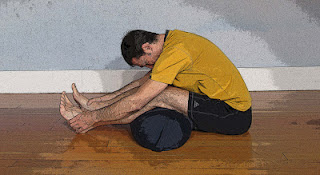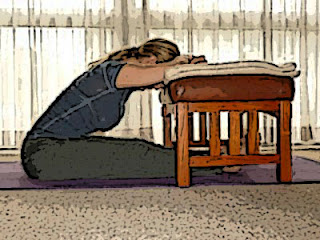Q: Nina’s post earlier this week on how to get comfortable in forward bends was very informative (see Getting Comfortable in Forward Bends). But I was wondering whether both versions shown in the photos–the one with the rounded back and the one with the neutral spine–are safe for everyone.
A: Forward bends always need to be approached with awareness, caution and respect, especially for people with acute low back injuries or chronic low back conditions. People with herniated discs, facet irritation, or degenerative joint conditions in their spines may find that too much bending forward will increase their pain.
Several leg muscles attach to your pelvis and tight leg muscles can restrict the movement of your pelvis, which needs to be able to roll over the top of your hip joints. If your leg muscles are tight, sometimes sitting on a folded blanket can allow you to get the proper movement of your pelvis. However, if you have very tight hamstrings and don’t have the ability to keep the natural curve in your low back as you bend forward, then the version with the bolster under your thighs may still be problematic.
 |
| Rounded Back Version: Could Be Problematic |
In addition, there are some people with conditions for which forward bends are contraindicated, meaning that the risk is greater than the benefit. This includes individuals with severe osteoporosis as well as individuals who may have had vertebral compression fractures in the past. For them the neutral spine version with the chair or bench may be safe, but, again, be sure to proceed with caution.
 |
| Neutral Spine Version: Proceed With Caution |
In general, cultivating flexibility in your hip rotators and hamstrings can help you achieve a neutral spine in your forward bends, which will help keep your lower back safe.
—Shari
Follow Yoga for Healthy Aging on Facebook ° To order Yoga for Healthy Aging: A Guide to Lifelong Well-Being, go to Amazon, Shambhala, Indie Bound or your local bookstore.


Leave A Comment